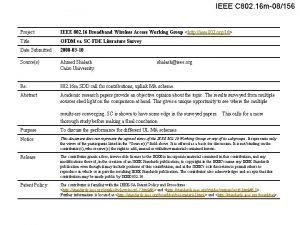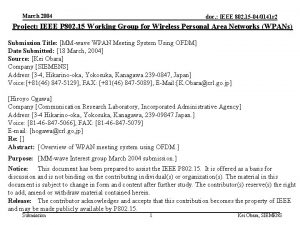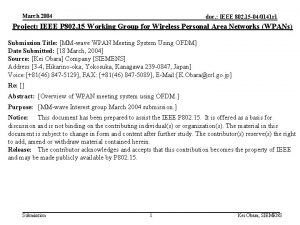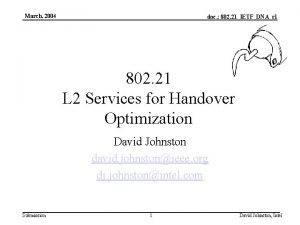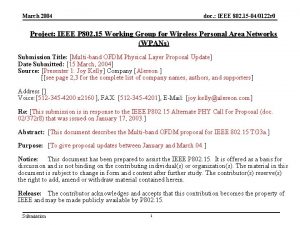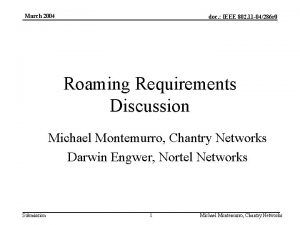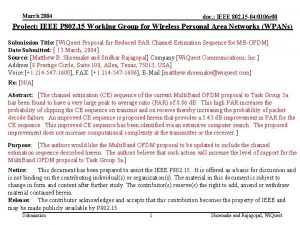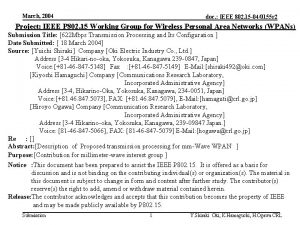March 2004 doc IEEE 802 15 040141 r













- Slides: 13

March 2004 doc. : IEEE 802. 15 -04/0141 r 1 Project: IEEE P 802. 15 Working Group for Wireless Personal Area Networks (WPANs) Submission Title: [MM-wave WPAN Meeting System Using OFDM] Date Submitted: [18 March, 2004] Source: [Kei Obara] Company [SIEMENS] Address [3 -4, Hikarino-oka, Yokosuka, Kanagawa 239 -0847, Japan] Voice: [+81(46) 847 -5129], FAX: [+81(46) 847 -5089], E-Mail: [K. Obara@crl. go. jp] Re: [] Abstract: [Overview of WPAN meeting system using OFDM. ] Purpose: [MM-wave Interest group March 2004 submission. ] Notice: This document has been prepared to assist the IEEE P 802. 15. It is offered as a basis for discussion and is not binding on the contributing individual(s) or organization(s). The material in this document is subject to change in form and content after further study. The contributor(s) reserve(s) the right to add, amend or withdraw material contained herein. Release: The contributor acknowledges and accepts that this contribution becomes the property of IEEE and may be made publicly available by P 802. 15. Submission 1 Kei Obara, SIEMENS

March 2004 doc. : IEEE 802. 15 -04/0141 r 1 MM-Wave WPAN Meeting System using OFDM Kei Obara SIEMENS Submission 2 Kei Obara, SIEMENS

March 2004 doc. : IEEE 802. 15 -04/0141 r 1 Background At the campus or company, meeting could be taken place at any place where people meet. High speed WPAN is suitable for nomadic meeting support system because of easy network setup. This application u Requires : High data rate, Secure access u Doesn’t require : Long distance transmission, High mobility Millimeter wave could be a good solution Submission 3 Kei Obara, SIEMENS

March 2004 doc. : IEEE 802. 15 -04/0141 r 1 Main features of the system ü Wideband OFDM in MM-Wave band --- taking advantage of sufficient bandwidth in 60 -70 GHz. ü 2 different protocols implemented (a) Ad Hoc protocol – enables automatic master-slave configuration (b) Multi-hop protocol – avoids NLOS problem in MM-Wave Submission 4 Kei Obara, SIEMENS

March 2004 doc. : IEEE 802. 15 -04/0141 r 1 Why OFDM ? • Wide band antenna is preferred for this system --- users don’t have to adjust antenna direction • By using wide band antenna, the system experiences strong multipath effect in millimeter wave band By using OFDM, multipath effect can be minimized Submission 5 Kei Obara, SIEMENS

March 2004 doc. : IEEE 802. 15 -04/0141 r 1 Major parameters of prototype system Submission 6 Kei Obara, SIEMENS

March 2004 doc. : IEEE 802. 15 -04/0141 r 1 Ad hoc Protocol -- Concept Terminal 1 First terminal becomes Master Terminal 2 Terminal 3 Switched on Master Slave Time 1 Master + 2 Slaves System When the Master is switched off, another terminal becomes Master (selectable by different length of timer) Switched on Slave Switched OFF Any Slave terminal is able to become Master by sending mode change request Master Slave Mode Change Request Master ² The test protocol was developed to meet the requirements in a small office or home environment ² In the initial stage, Master / Slave mode is selectable. Slaves are synchronized to Master ² A slave can change to a master in case a master was stopped or transferred into a slave mode ² The AP down command from any given MT in the network enables the user remotely to turn an AP into a MT Submission 7 Kei Obara, SIEMENS

March 2004 doc. : IEEE 802. 15 -04/0141 r 1 Multi-hop Protocol – Concept (case 1) EP (Extension Point) MT(Mobile Terminal) AP (Access Point) Case 1: When AP and MT are in NLOS condition, MT start a link via EP. Submission 8 Kei Obara, SIEMENS

March 2004 doc. : IEEE 802. 15 -04/0141 r 1 Multi-hop Protocol – Concept (case 2) EP in rl (Extension Point) k te t Be MT(Mobile Terminal) AP (Access Point) Case 2: MT keeps watching 2 links and use the better one to access to AP. Submission 9 Kei Obara, SIEMENS

March 2004 doc. : IEEE 802. 15 -04/0141 r 1 Developed system IF adaptor 70 GHz RF front end with 60 degrees antenna Baseband Submission 10 Kei Obara, SIEMENS

March 2004 doc. : IEEE 802. 15 -04/0141 r 1 Conclusions ü Short range (2 -4 m ? ? ) and high speed WPAN system could be one of expected applications of mm-wave systems ü OFDM is employed for mm-wave WPAN system to reduce maltipath effect ü Ad hoc protocol has been implemented into the OFDM modem for easy network set up for small office/ meeting scenario. ü Multi hop protocol has been implemented ad minimize NLOS problem in millimeter wave ad hoc scenario Submission 11 Kei Obara, SIEMENS

March 2004 doc. : IEEE 802. 15 -04/0141 r 1 Backup slides Submission 12 Kei Obara, SIEMENS

March 2004 doc. : IEEE 802. 15 -04/0141 r 1 Linkbudget @ 70 GHz , distance=4 m Submission Distance 4 m TX power TX antenna gain Path loss @ 4 m RX antenna gain 8 d. Bm 8 d. B 81. 4 d. B 8 d. B Received power -61. 4 d. Bm k. TB (@300 K) Bandwidth NF -174 d. Bm/Hz 100 MHz 8 d. B Thermal noise -86 d. Bm CNR 24 d. B 13 Kei Obara, SIEMENS













